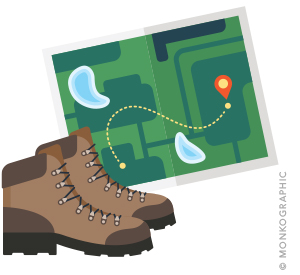
Fam Pract Manag. 2019;26(2):32
PAVE A TRAIL FOR SEDENTARY PATIENTS

Getting sedentary patients to exercise can be a challenge. I often encourage them to reinitiate an activity they enjoyed when they were younger because I believe they are more likely to stick with it. But it can be difficult if the patient only liked team sports, so instead I will advise him or her to start walking more. I’ve found that giving the patient detailed instructions in either paper or electronic form, including walk duration and number of days, can help. To make it easier and address common barriers to exercise, our practice developed a guide that details places patients can walk in our area, which we offer on our practice website. Our office staff has visited most of the sites, and our guide includes the ease of terrain, quality of trail surfaces, hours of operation, type and location of parking, and availability of restrooms.
IDENTIFY WHAT MATTERS TO OLDER PATIENTS
As patients get older, they tend to accumulate health conditions, such as heart issues or diabetes, and undergo major life changes, including physical or memory limitations. Physicians are trained to focus on curing or treating as many health problems as possible, but in the process, they can lose focus on what outcomes matter most to the patient. To avoid this, address the “4Ms”:
What Matters (What outcomes are most important to the patient?)
Medication (What are the drug’s side effects?)
Mentation (Is the patient affected by depression, dementia, or delirium?)
Mobility (How well can the patient move around?)
Make sure you address these issues as a whole, not individually, which can be confusing and sometimes contradictory. For example, a patient with Parkinson’s disease typically has trouble with mobility. The medications used to treat Parkinson’s can improve mobility but degrade memory or the ability to think clearly, affecting other important facets of the patient’s life. However, if you approach the 4Ms as a related whole and communicate with the patient to determine what is most important, the inevitable tradeoffs of senior care will be simplified because you will now know where to focus and how to provide more balanced treatment.
REDUCE THE TIME YOU SPEND ON EMAIL

Like other professionals, physicians get a lot of email. Managing those messages takes a lot of time out of your day, time that could be better spent treating your patients or running your practice. You can’t ignore email completely, but you can make it work better for you. Use these five steps to help reduce the intrusion of email into your daily work life and make it — and you — more efficient:
Turn off email notifications, and schedule time to check your email once an hour.
Once you have read an email, either delete it or move it out of your inbox and into a folder.
Create only two email folders — one for emails that require further action and one for emails you might want to read later — and move all saved emails into one of those, preferably with the use of shortcut commands.
If you need to find an important email you have already read, use your program’s search function instead of manually searching for it.
Unsubscribe from or block as spam irrelevant emails instead of taking time to delete them individually.
